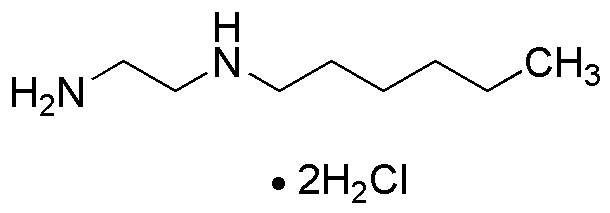N-Hexylethylenediamine dihydrochloride is widely utilized in research focused on:
- Polymer Chemistry: It serves as a chain extender in the synthesis of polyurethanes, enhancing the mechanical properties of the resulting materials, making them more durable and flexible.
- Pharmaceuticals: This compound is used in drug formulation as a stabilizing agent, improving the solubility and bioavailability of active pharmaceutical ingredients, which is crucial for effective medication delivery.
- Surface Coatings: It acts as a curing agent in epoxy resins, providing superior adhesion and chemical resistance, which is essential for protective coatings in industrial applications.
- Textile Industry: Employed as a finishing agent, it enhances the water repellency and stain resistance of fabrics, thereby increasing their longevity and performance in various environments.
- Biotechnology: It is utilized in the production of biosensors, where its ability to form stable complexes with biomolecules improves the sensitivity and accuracy of detection methods.
General Information
Properties
Safety and Regulations
Applications
N-Hexylethylenediamine dihydrochloride is widely utilized in research focused on:
- Polymer Chemistry: It serves as a chain extender in the synthesis of polyurethanes, enhancing the mechanical properties of the resulting materials, making them more durable and flexible.
- Pharmaceuticals: This compound is used in drug formulation as a stabilizing agent, improving the solubility and bioavailability of active pharmaceutical ingredients, which is crucial for effective medication delivery.
- Surface Coatings: It acts as a curing agent in epoxy resins, providing superior adhesion and chemical resistance, which is essential for protective coatings in industrial applications.
- Textile Industry: Employed as a finishing agent, it enhances the water repellency and stain resistance of fabrics, thereby increasing their longevity and performance in various environments.
- Biotechnology: It is utilized in the production of biosensors, where its ability to form stable complexes with biomolecules improves the sensitivity and accuracy of detection methods.
Documents
Safety Data Sheets (SDS)
The SDS provides comprehensive safety information on handling, storage, and disposal of the product.
Product Specification (PS)
The PS provides a comprehensive breakdown of the product’s properties, including chemical composition, physical state, purity, and storage requirements. It also details acceptable quality ranges and the product's intended applications.
Certificates of Analysis (COA)
Search for Certificates of Analysis (COA) by entering the products Lot Number. Lot and Batch Numbers can be found on a product’s label following the words ‘Lot’ or ‘Batch’.
*Catalog Number
*Lot Number
Certificates Of Origin (COO)
This COO confirms the country where the product was manufactured, and also details the materials and components used in it and whether it is derived from natural, synthetic, or other specific sources. This certificate may be required for customs, trade, and regulatory compliance.
*Catalog Number
*Lot Number
Safety Data Sheets (SDS)
The SDS provides comprehensive safety information on handling, storage, and disposal of the product.
DownloadProduct Specification (PS)
The PS provides a comprehensive breakdown of the product’s properties, including chemical composition, physical state, purity, and storage requirements. It also details acceptable quality ranges and the product's intended applications.
DownloadCertificates of Analysis (COA)
Search for Certificates of Analysis (COA) by entering the products Lot Number. Lot and Batch Numbers can be found on a product’s label following the words ‘Lot’ or ‘Batch’.
*Catalog Number
*Lot Number
Certificates Of Origin (COO)
This COO confirms the country where the product was manufactured, and also details the materials and components used in it and whether it is derived from natural, synthetic, or other specific sources. This certificate may be required for customs, trade, and regulatory compliance.

